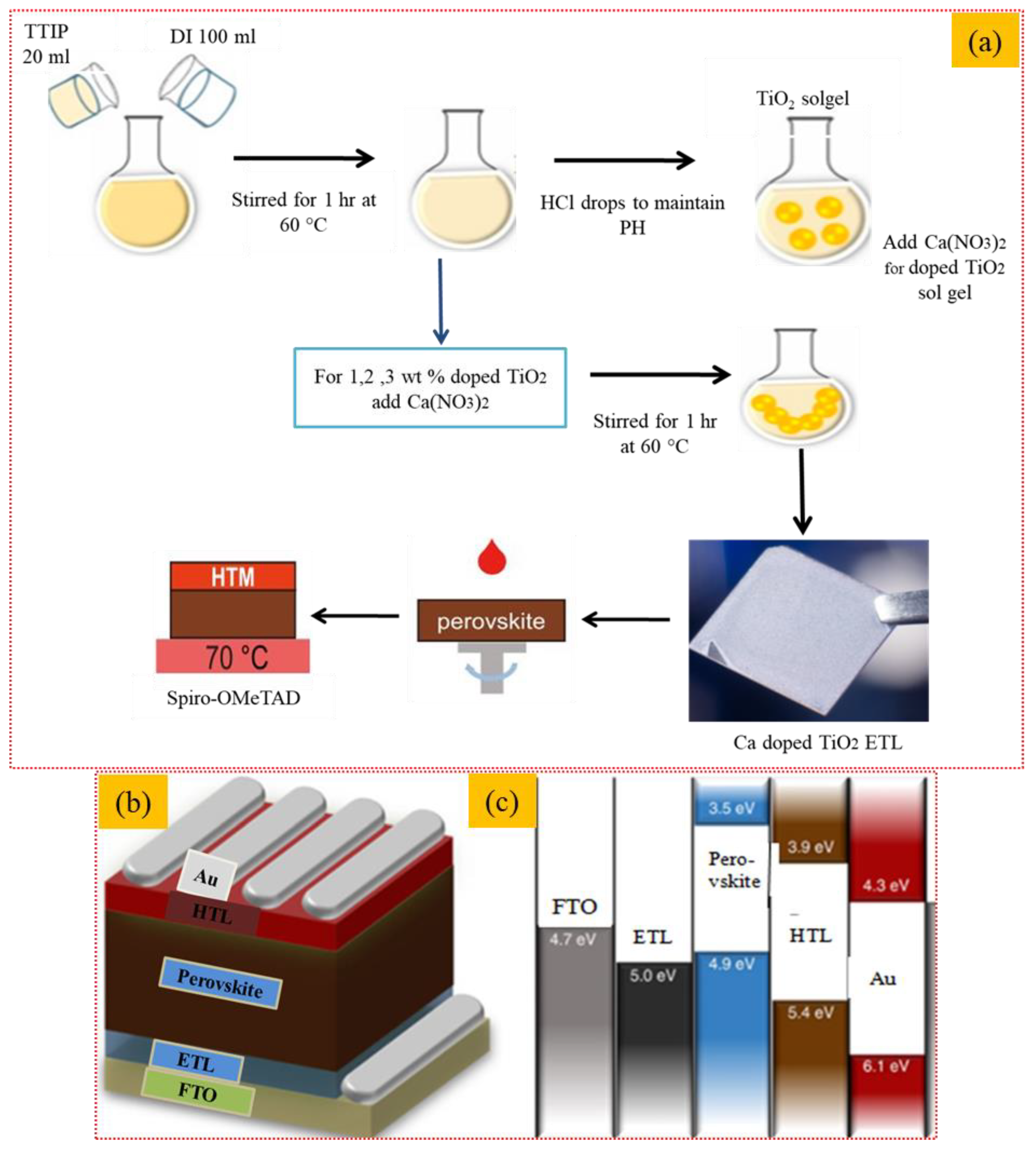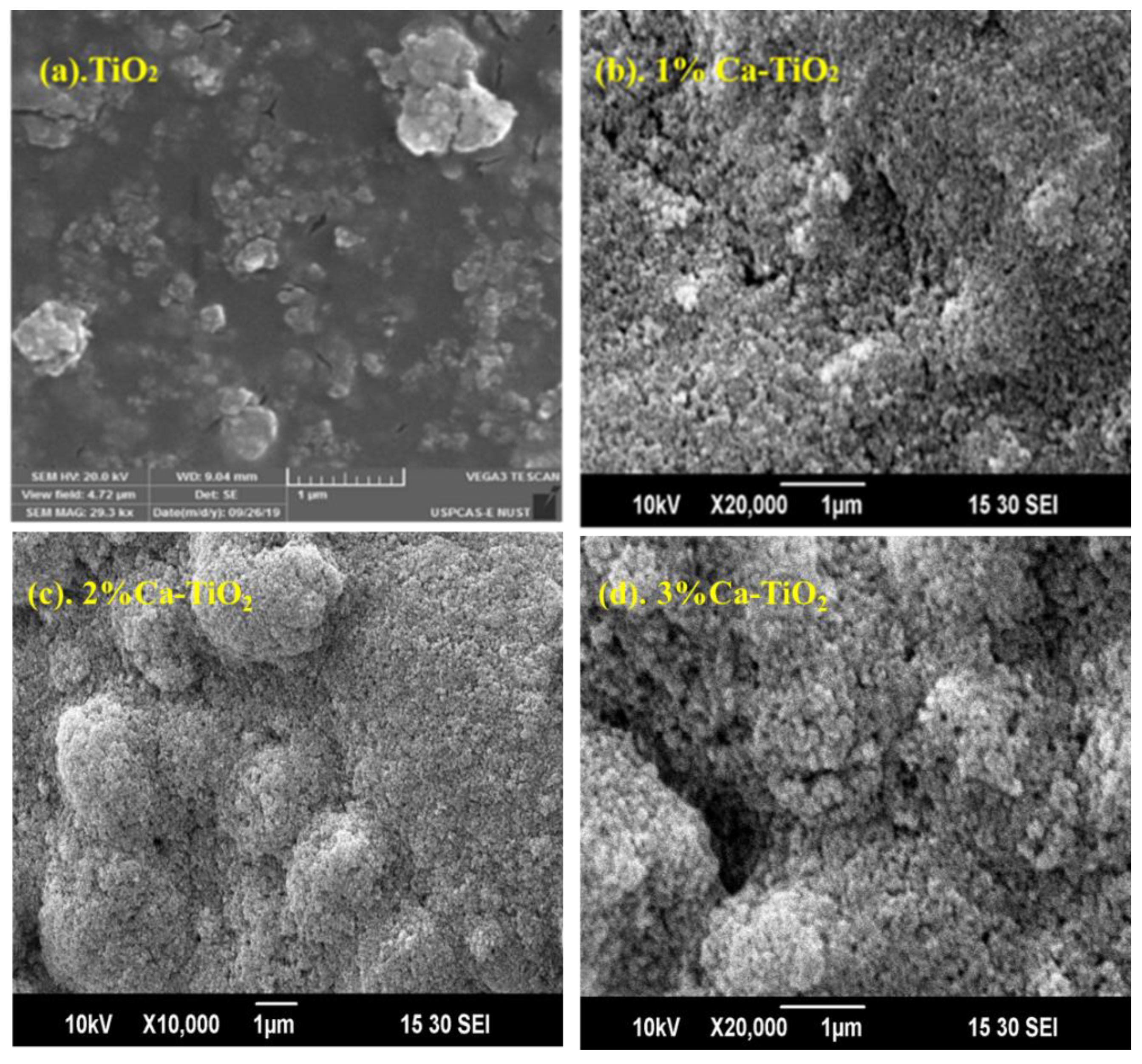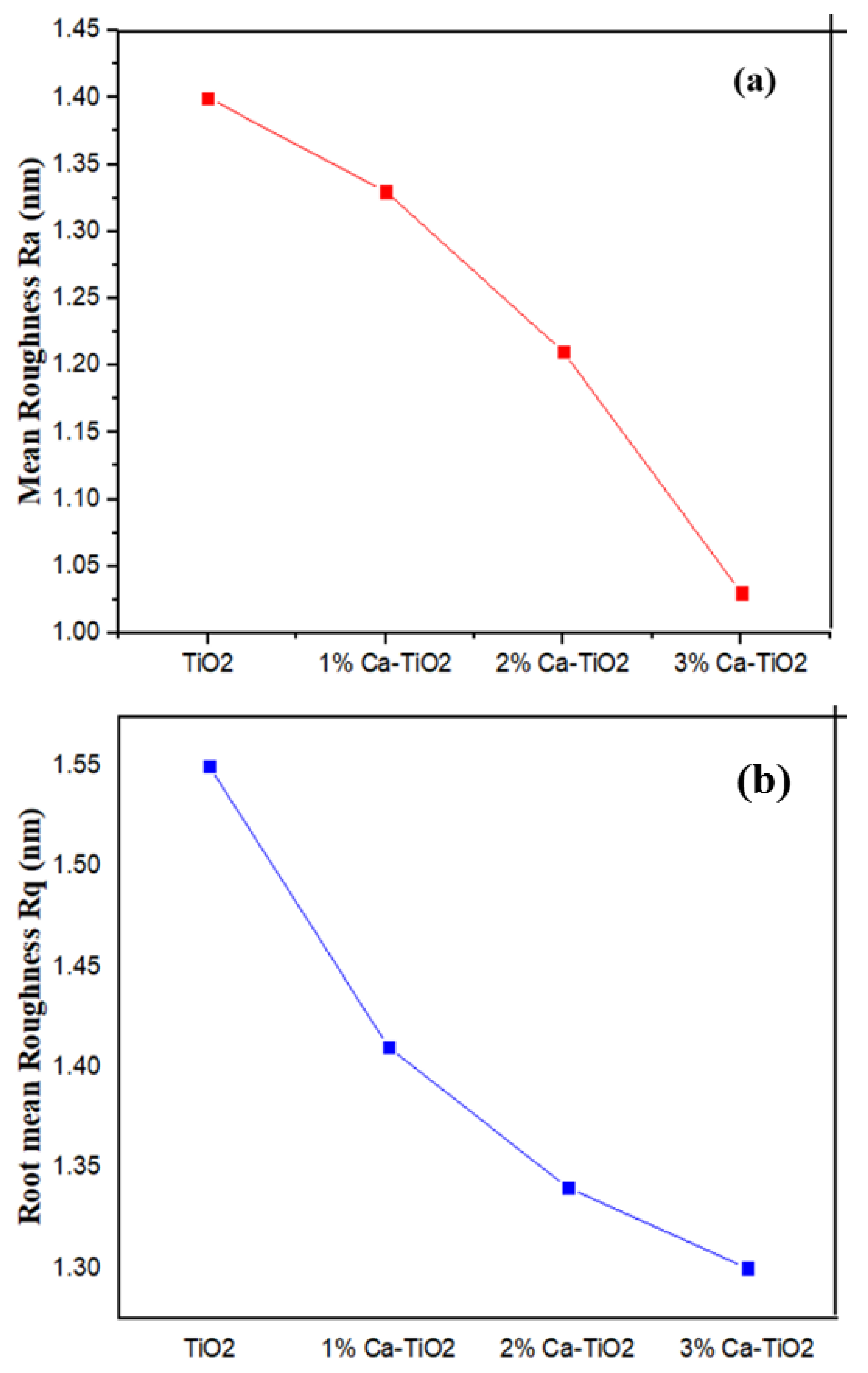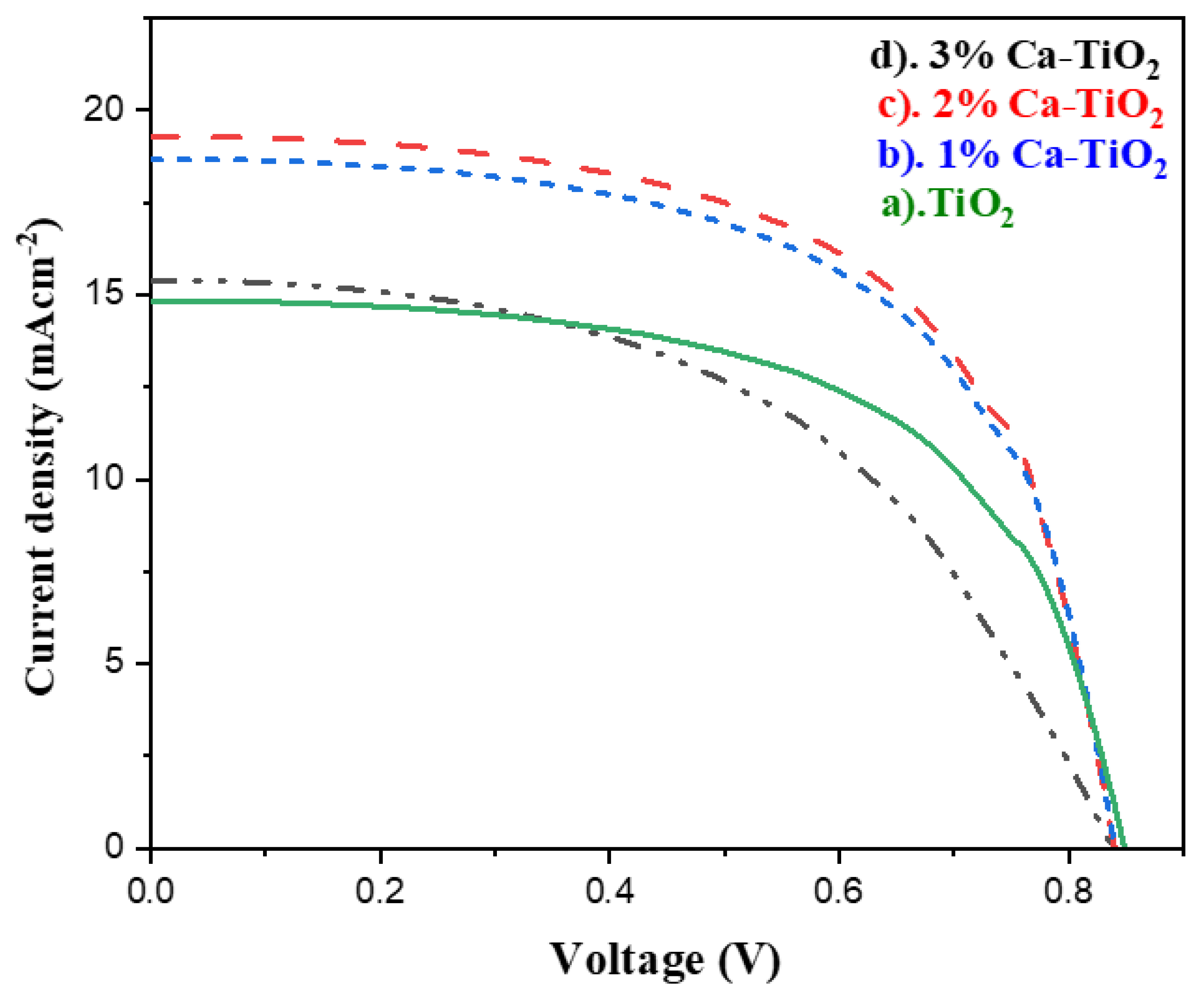Performance Analysis of Calcium-Doped Titania (TiO2) as an Effective Electron Transport Layer (ETL) for Perovskite Solar Cells
Abstract
:1. Introduction
2. Materials and Methods
2.1. Synthesis of TiO2 Sol-Gel
2.2. Fabrication of Perovskite Solar Cell
2.3. Material Characterizations
2.4. Electrical Characteristics Testing
3. Results and Discussion
4. Conclusions
Author Contributions
Funding
Institutional Review Board Statement
Informed Consent Statement
Data Availability Statement
Acknowledgments
Conflicts of Interest
References
- Ritchie, H.; Roser, M. Energy, Our World in Data. 2020. Available online: https://ourworldindata.org/energy (accessed on 20 December 2021).
- Valadi, K.; Gharibi, S.; Taheri-Ledari, R.; Akin, S.; Maleki, A.; Shalan, A.E. Metal oxide electron transport materials for perovskite solar cells: A review. Environ. Chem. Lett. 2021, 19, 2185–2207. [Google Scholar] [CrossRef]
- Tariq, M.A.; Shahzad, N.; Sattar, A.; Ahmad, M.; Anwar, M.; Shahzad, M.I. Role of bi-layered CuSCN based hole transport films to realize highly efficient and stable perovskite solar cells. Surf. Interfaces 2022, 28, 101657. [Google Scholar] [CrossRef]
- Yang, G.; Tao, H.; Qin, P.; Ke, W.; Fang, G. Recent progress in electron transport layers for efficient perovskite solar cells. J. Mater. Chem. A 2016, 4, 3970–3990. [Google Scholar] [CrossRef]
- Hossain, M.I.; Hasan, A.K.M.; Qarony, W.; Shahiduzzaman, M.; Islam, M.A.; Ishikawa, Y.; Uraoka, Y.; Amin, N.; Knipp, D.; Akhtaruzzaman, M.; et al. Electrical and Optical Properties of Nickel-Oxide Films for Efficient Perovskite Solar Cells. Small Methods 2020, 4, 2000454. [Google Scholar] [CrossRef]
- Ameer, A.; Shahzad, N.; Tariq, M.A.; Khan, Z.S.; Batool, B.; Haq, S.; Shahzad, M.I. NiO and MWCNT based hole transporting layers for solar cell applications. Bull. Mater. Sci. 2022, 45, 1–9. [Google Scholar] [CrossRef]
- Shadrokh, Z.; Sousani, S.; Gholipour, S.; Abdi, Y. Enhanced photovoltaic performance and stability of perovskite solar cells by interface engineering with poly(4-vinylpyridine) and Cu2ZnSnS4 & CNT. Sol. Energy 2020, 201, 908–915. [Google Scholar] [CrossRef]
- Ahmad, M.; Shahzad, N.; Tariq, M.A.; Sattar, A.; Pugliese, D. Investigating the Sequential Deposition Route for Mixed Cation Mixed Halide Wide Bandgap Perovskite Absorber Layer. Energies 2021, 14, 8401. [Google Scholar] [CrossRef]
- Kanwal, M.; Shahzad, N.; Tariq, M.A.; Shahzad, M.I. Effectively transparent electrical contacts for thermally sensitive solar cells. Sol. Energy Mater. Sol. Cells 2021, 224, 110973. [Google Scholar] [CrossRef]
- Choi, J.; Song, S.; Hörantner, M.T.; Snaith, H.; Park, T. Well-Defined Nanostructured, Single-Crystalline TiO2 Electron Transport Layer for Efficient Planar Perovskite Solar Cells. ACS Nano 2016, 10, 6029–6036. [Google Scholar] [CrossRef]
- Zheng, Y.; Kong, J.; Huang, D.; Shi, W.; McMillon-Brown, L.; Katz, H.E.; Yu, J.; Taylor, A.D. Spray coating of the PCBM electron transport layer significantly improves the efficiency of p-i-n planar perovskite solar cells. Nanoscale 2018, 10, 11342–11348. [Google Scholar] [CrossRef]
- Namkoong, G.; Mamun, A.A.; Ava, T.T. Impact of PCBM/C60 electron transfer layer on charge transports on ordered and disordered perovskite phases and hysteresis-free perovskite solar cells. Org. Electron. 2018, 56, 163–169. [Google Scholar] [CrossRef]
- Park, S.; Kang, R.; Cho, S. Effect of an Al-doped ZnO electron transport layer on the efficiency of inverted bulk heterojunction solar cells. Curr. Appl. Phys. 2020, 20, 172–177. [Google Scholar] [CrossRef]
- Shahiduzzaman, M.; Hossain, M.I.; Visal, S.; Kaneko, T.; Qarony, W.; Umezu, S.; Tomita, K.; Iwamori, S.; Knipp, D.; Tsang, Y.H.; et al. Spray Pyrolyzed TiO2 Embedded Multi-Layer Front Contact Design for High-Efficiency Perovskite Solar Cells. Nano-Micro. Lett. 2021, 13, 1–17. [Google Scholar] [CrossRef] [PubMed]
- Pan, M.; Liu, H.; Yao, Z.; Zhong, X. Enhanced Efficiency of Dye-Sensitized Solar Cells by Trace Amount Ca-Doping in TiO2 Photoelectrodes. J. Nanomater. 2015, 2015, 974161. [Google Scholar] [CrossRef]
- Hossain, M.I.; Shahiduzzaman, M.; Ahmed, S.; Huqe, R.; Qarony, W.; Saleque, A.M.; Akhtaruzzaman, M.; Knipp, D.; Tsang, Y.H.; Taima, T.; et al. Near field control for enhanced photovoltaic performance and photostability in perovskite solar cells. Nano Energy 2021, 89, 106388. [Google Scholar] [CrossRef]
- Fakharuddin, A.; Di Giacomo, F.; Ahmed, I.; Wali, Q.; Brown, T.M.; Jose, R. Role of morphology and crystallinity of nanorod and planar electron transport layers on the performance and long term durability of perovskite solar cells. J. Power Sources 2015, 283, 61–67. [Google Scholar] [CrossRef] [Green Version]
- Castro, Y.; Arconada, N.; Durán, A. Synthesis and photocatalytic characterisation of mesoporous TiO2 films doped with Ca, W and N. Boletín Soc. Española Cerámica Vidr. 2015, 54, 11–20. [Google Scholar] [CrossRef] [Green Version]
- Hsu, C.-H.; Chen, K.-T.; Lin, L.-Y.; Wu, W.-Y.; Liang, L.-S.; Gao, P.; Qiu, Y.; Zhang, X.-Y.; Huang, P.-H.; Lien, S.-Y.; et al. Tantalum-Doped TiO2 Prepared by Atomic Layer Deposition and Its Application in Perovskite Solar Cells. Nanomaterials 2021, 11, 1504. [Google Scholar] [CrossRef]
- Ren, X.; Xie, L.; Bin Kim, W.; Lee, D.G.; Jung, H.S.; Liu, F. Chemical Bath Deposition of Co-Doped TiO2 Electron Transport Layer for Hysteresis-Suppressed High-Efficiency Planar Perovskite Solar Cells. Sol. RRL 2019, 3, 1900176. [Google Scholar] [CrossRef]
- Arshad, Z.; Khoja, A.H.; Shakir, S.; Afzal, A.; Mujtaba, M.A.; Soudagar, M.E.; Fayaz, H.; Farukh, S.; Saeed, M. Magnesium doped TiO2 as an efficient electron transport layer in perovskite solar cells. Case Stud. Therm. Eng. 2021, 26, 101101. [Google Scholar] [CrossRef]
- Shelhammer, D.; Cao, X.; Liu, N.; Wang, H.; Zhou, Y. Doping effects and stability of calcium in organic electron-transport materials. Org. Electron. 2020, 84, 105799. [Google Scholar] [CrossRef]
- Ranjitha, A.; Thambidurai, M.; Shini, F.; Muthukumarasamy, N.; Velauthapillai, D. Effect of doped TiO2 film as electron transport layer for inverted organic solar cell. Mater. Sci. Energy Technol. 2019, 2, 385–388. [Google Scholar] [CrossRef]
- Javed, A.H.; Shahzad, N.; Butt, F.A.; Khan, M.A.; Naeem, N.; Liaquat, R.; Khoja, A.H. Synthesis of bimetallic Co-Ni/ZnO nanoprisms (ZnO-NPr) for hydrogen-rich syngas production via partial oxidation of methane. J. Environ. Chem. Eng. 2021, 9, 106887. [Google Scholar] [CrossRef]
- Musa, M.; Mamat, M.; Vasimalai, N.; Banu, I.S.; Malek, M.; Ahmad, M.; Suriani, A.; Mohamed, A.; Rusop, M. Fabrication and structural properties of flower-like TiO2 nanorod array films grown on glass substrate without FTO layer. Mater. Lett. 2020, 273, 127902. [Google Scholar] [CrossRef]
- Yusoff, M.M.; Mamat, M.H.; Ismail, A.S.; Malek, M.F.; Zoolfakar, A.S.; Suriani, A.B.; Ahmad, M.K.; Nayan, N.; Banu, I.B.S.; Rusop, M. Low-temperature-dependent growth of titanium dioxide nanorod arrays in an improved aqueous chemical growth method for photoelectrochemical ultraviolet sensing. J. Mater. Sci. Mater. Electron. 2019, 30, 1017–1033. [Google Scholar] [CrossRef]
- Yusoff, M.; Mamat, M.; Abdullah, M.; Ismail, A.; Malek, M.; Zoolfakar, A.; Al Junid, S.A.M.; Suriani, A.; Mohamed, A.; Ahmad, M.; et al. Coupling heterostructure of thickness-controlled nickel oxide nanosheets layer and titanium dioxide nanorod arrays via immersion route for self-powered solid-state ultraviolet photosensor applications. Measurement 2020, 149, 106982. [Google Scholar] [CrossRef]
- Yusoff, M.; Mamat, M.; Ismail, A.; Malek, M.; Khusaimi, Z.; Suriani, A.; Mohamed, A.; Ahmad, M.; Rusop, M. Enhancing the performance of self-powered ultraviolet photosensor using rapid aqueous chemical-grown aluminum-doped titanium oxide nanorod arrays as electron transport layer. Thin Solid Film. 2018, 655, 1–12. [Google Scholar] [CrossRef]
- Raza, J.; Khoja, A.H.; Naqvi, S.R.; Mehran, M.T.; Shakir, S.; Liaquat, R.; Ali, G. Methane decomposition for hydrogen production over biomass fly ash-based CeO2 nanowires promoted cobalt catalyst. J. Env. Che. Eng. 2021, 9, 105816. [Google Scholar] [CrossRef]
- Castro, Y.; Durán, A. Ca doping of mesoporous TiO2 films for enhanced photocatalytic efficiency under solar irradiation. J. Sol-Gel Sci. Technol. 2016, 78, 482–491. [Google Scholar] [CrossRef]
- Shakir, S.; Khan, Z.; Ali, A.; Akbar, N.; Musthaq, W. Development of copper doped titania based photoanode and its performance for dye sensitized solar cell applications. J. Alloy. Compd. 2015, 652, 331–340. [Google Scholar] [CrossRef]
- Cheng, X.; Yu, X.; Xing, Z.; Wan, J. Enhanced Photocatalytic Activity of Nitrogen Doped TiO2 Anatase Nano-Particle under Simulated Sunlight Irradiation. Energy Procedia 2012, 16, 598–605. [Google Scholar] [CrossRef] [Green Version]
- Liu, Q. Photovoltaic Performance Improvement of Dye-Sensitized Solar Cells Based on Mg-Doped TiO2 Thin Films. Electrochim. Acta 2014, 129, 459–462. [Google Scholar] [CrossRef]
- Lu, H.; Tian, W.; Gu, B.; Zhu, Y.; Li, L. TiO2 Electron Transport Bilayer for Highly Efficient Planar Perovskite Solar Cell. Small 2017, 13, 1701535. [Google Scholar] [CrossRef] [PubMed]
- Sriubas, M.; Bočkutė, K.; Virbukas, D.; Laukaitis, G. Investigation of the Properties of Ca-doped TiO2 Thin Films Formed by e-beam Evaporation. Procedia Eng. 2014, 98, 133–138. [Google Scholar] [CrossRef] [Green Version]
- Zhang, H.; Shi, J.; Xu, X.; Zhu, L.; Luo, Y.; Li, D.; Meng, Q. Mg-doped TiO2 boosts the efficiency of planar perovskite solar cells to exceed 19%. J. Mater. Chem. A 2016, 4, 15383–15389. [Google Scholar] [CrossRef]
- Istrate, A.-I.; Nastase, F.; Mihalache, I.; Comanescu, F.; Gavrila, R.; Tutunaru, O.; Romanitan, C.; Tucureanu, V.; Nedelcu, M.; Müller, R. Synthesis and characterization of Ca doped ZnO thin films by sol–gel method. J. Sol-Gel Sci. Technol. 2019, 92, 585–597. [Google Scholar] [CrossRef]
- Wang, J.; Yu, J.; Zhu, X.; Kong, X.Z. Preparation of hollow TiO2 nanoparticles through TiO2 deposition on polystyrene latex particles and characterizations of their structure and photocatalytic activity. Nanoscale Res. Lett. 2012, 7, 646. [Google Scholar] [CrossRef] [Green Version]
- Lu, P.-J.; Huang, S.-C.; Chen, Y.-P.; Chiueh, L.-C.; Shih, D.Y.-C. Analysis of titanium dioxide and zinc oxide nanoparticles in cosmetics. J. Food Drug Anal. 2015, 23, 587–594. [Google Scholar] [CrossRef] [Green Version]
- Tang, H.; Prasad, K.; Sanjinès, R.; Schmid, P.E.; Lévy, F. Electrical and optical properties of TiO2 anatase thin films. J. Appl. Phys. 1994, 75, 2042–2047. [Google Scholar] [CrossRef]
- Yang, M. Band Gap Engineering and Carrier Transport in TiO2 for Solar Energy Harvesting. Doctoral Dissertation, University of Pittsburgh, Pittsburgh, PA, USA, 2012. [Google Scholar]
- Javed, A.H.; Shahzad, N.; Khan, M.A.; Ayub, M.; Iqbal, N.; Hassan, M.; Hussain, N.; Rameel, M.I.; Shahzad, M.I. Effect of ZnO nanostructures on the performance of dye sensitized solar cells. Sol. Energy 2021, 230, 492–500. [Google Scholar] [CrossRef]
- Hernandez, J.V. Structural and Morphological Modification of TiO2 Doped Metal Ions and Investigation of Photo-Induced Charge Transfer Processes. Doctoral Dissertation, Université du Maine, Mexico City, Mexico, 2017. [Google Scholar]
- Liu, X.; Bi, Y. Synergistic effect of Ti3+ doping and facet regulation over Ti3+-doped TiO2 nanosheets with enhanced photoreactivity. Catal. Sci. Technol. 2018, 8, 3876–3882. [Google Scholar] [CrossRef]
- Zhang, X.; Stroud, D. Optical and electrical properties of thin films. Phys. Rev. B 1995, 52, 2131. [Google Scholar] [CrossRef] [PubMed]
- Ramaneti, R.; Lodder, J.C.; Jansen, R. Anomalous Hall effect in anatase Co:TiO2 ferromagnetic semiconductor. Appl. Phys. Lett. 2007, 91, 12502. [Google Scholar] [CrossRef] [Green Version]
- Tavakoli, M.M.; Yadav, P.; Tavakoli, R.; Kong, J. Surface engineering of TiO2 ETL for highly efficient and hysteresis-less planar perovskite solar cell (21.4%) with enhanced open-circuit voltage and stability. Adv. Energy Mater. 2018, 8, 1800794. [Google Scholar] [CrossRef]
- Minchi, L.; Cao, F.; Xinni, Z.; Youqiang, C.; Xuhua, L. Photocatalytic activity of Ca-TiO2 nanofibers with different concentrations of calcium. Chem. Phys. Lett. 2019, 736, 136807. [Google Scholar] [CrossRef]
- Shahiduzzaman, M.; Hossain, M.I.; Otani, S.; Wang, L.; Umezu, S.; Kaneko, T.; Iwamori, S.; Tomita, K.; Tsang, Y.H.; Akhtaruzzaman, M.; et al. Low-temperature treated anatase TiO2 nanophotonic-structured contact design for efficient triple-cation perovskite solar cells. Chem. Eng. J. 2021, 426, 131831. [Google Scholar] [CrossRef]
- Liu, Q.; Zhou, Y.; Duan, Y.; Wang, M.; Zhao, X.; Lin, Y. Enhanced conversion efficiency of dye-sensitized titanium dioxide solar cells by Ca-doping. J. Alloy. Compd. 2013, 548, 161–165. [Google Scholar] [CrossRef]
- Teimouri, R.; Heydari, Z.; Ghaziani, M.P.; Madani, M.; Abdy, H.; Kolahdouz, M.; Asl-Soleimani, E. Synthesizing Li doped TiO2 electron transport layers for highly efficient planar perovskite solar cell. Superlattices Microstruct. 2020, 145, 106627. [Google Scholar] [CrossRef]
- Nguyen, T.M.H.; Bark, C.W. Synthesis of Cobalt-Doped TiO2 Based on Metal–Organic Frameworks as an Effective Electron Transport Material in Perovskite Solar Cells. ACS Omega 2020, 5, 2280–2286. [Google Scholar] [CrossRef] [Green Version]








| Sample Name | Diffraction Angle2 θ (°) | FWHM | Crystallite Size D (nm) | Microstrain ε | Dislocation Density, δ (1014 lines/m2) |
|---|---|---|---|---|---|
| TiO2 | 25.48 | 0.344 | 25 | 0.38 | 16.0 |
| 1 wt% Ca TiO2 | 25.48 | 0.397 | 21 | 0.44 | 22.7 |
| 2 wt% Ca TiO2 | 25.48 | 0.439 | 19 | 0.48 | 27.7 |
| 3 wt% Ca TiO2 | 25.48 | 0.487 | 17 | 0.54 | 34.6 |
| S.No. | Sample | Mean Roughness Ra (nm) | Root Mean Square Roughness Rq (nm) |
|---|---|---|---|
| 1 | TiO2 | 1.40 | 1.55 |
| 2 | 1% Ca-TiO2 | 1.33 | 1.41 |
| 3 | 2% Ca-TiO2 | 1.21 | 1.34 |
| 4 | 3% Ca-TiO2 | 1.03 | 1.30 |
| S.No. | Sample | Resistivity ρ (Ohm.cm) | Conductivityσ (1/Ohm.cm) | Sheet Resistance (Ohm-sq.) | Sheet Carrier Mobility μs (cm2/V.s) |
|---|---|---|---|---|---|
| 1 | TiO2 | 7.28 × 10−05 | 13,100 | 8.13 × 1000 | 3.19 × 1001 |
| 2 | 1% Ca-TiO2 | 7.36 × 10−05 | 13,500 | 6.51 × 1000 | 3.25 × 1001 |
| 3 | 2% Ca-TiO2 | 7.61 × 10−05 | 14,100 | 6.34 × 1000 | 3.36 × 1001 |
| 4 | 3% Ca-TiO2 | 7.31 × 10−05 | 13,300 | 6.66 × 1000 | 3.21 × 1001 |
| PSC | Voc (V) | Jsc (mA/cm2) | FF | η (%) |
|---|---|---|---|---|
| Undoped TiO2 PSC | 0.84 | 15.38 | 50.59 | 6.53 |
| 1% Ca TiO2 PSC | 0.84 | 18.66 | 60.47 | 9.48 |
| 2% Ca TiO2 PSC | 0.83 | 19.28 | 61.2 | 9.79 |
| 3% Ca TiO2 PSC | 0.83 | 14.83 | 59.76 | 7.27 |
| PSC | Voc (V) | Jsc (mA/cm2) | η (%) | Ref. |
|---|---|---|---|---|
| 3% Mg-TiO2-based PSC | 1.08 | 22.26 | 14.65 | [21] |
| Mg-doped TiO2 PSC (0.01) | 1.09 | 21.48 | 17.65 | [36] |
| 0.3 M Li-TiO2 PSC | 1.08 | Not given | 24.23 | [51] |
| 1 wt% Co-doped TiO2 PSC | 1.01 | 23.75 | 15.60 | [52] |
| Ta-doped TiO2 PSC | 1.11 | 22.80 | 17.91 | [19] |
| ZnO | 0.724 | 15.66 | 8.04 | [13] |
| AZO 1% | 0.724 | 15.94 | 8.27 | |
| AZO 3% | 0.726 | 16.06 | 8.34 | |
| AZO 5% | 0.725 | 16.61 | 8.68 | |
| AZO 7% | 0.725 | 17.04 | 8.98 | |
| AZO 10% | 0.725 | 14.15 | 7.08 |
Publisher’s Note: MDPI stays neutral with regard to jurisdictional claims in published maps and institutional affiliations. |
© 2022 by the authors. Licensee MDPI, Basel, Switzerland. This article is an open access article distributed under the terms and conditions of the Creative Commons Attribution (CC BY) license (https://creativecommons.org/licenses/by/4.0/).
Share and Cite
Arshad, Z.; Shakir, S.; Khoja, A.H.; Javed, A.H.; Anwar, M.; Rehman, A.; Javaid, R.; Qazi, U.Y.; Farrukh, S. Performance Analysis of Calcium-Doped Titania (TiO2) as an Effective Electron Transport Layer (ETL) for Perovskite Solar Cells. Energies 2022, 15, 1408. https://doi.org/10.3390/en15041408
Arshad Z, Shakir S, Khoja AH, Javed AH, Anwar M, Rehman A, Javaid R, Qazi UY, Farrukh S. Performance Analysis of Calcium-Doped Titania (TiO2) as an Effective Electron Transport Layer (ETL) for Perovskite Solar Cells. Energies. 2022; 15(4):1408. https://doi.org/10.3390/en15041408
Chicago/Turabian StyleArshad, Zafar, Sehar Shakir, Asif Hussain Khoja, Ahad Hussain Javed, Mustafa Anwar, Abdur Rehman, Rahat Javaid, Umair Yaqub Qazi, and Sarah Farrukh. 2022. "Performance Analysis of Calcium-Doped Titania (TiO2) as an Effective Electron Transport Layer (ETL) for Perovskite Solar Cells" Energies 15, no. 4: 1408. https://doi.org/10.3390/en15041408







